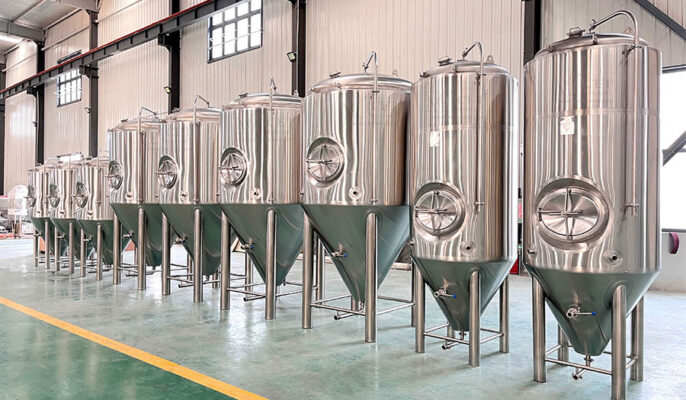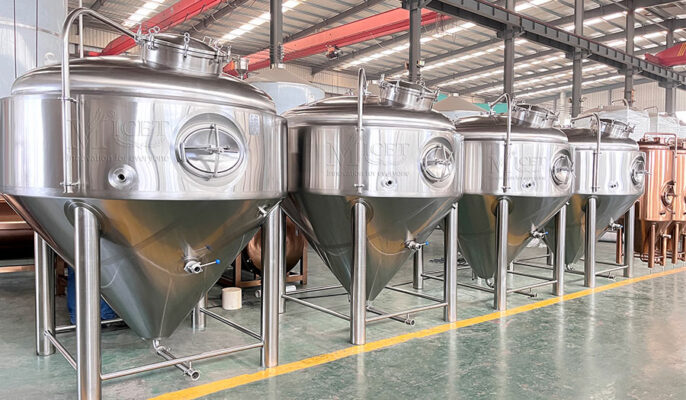The fermenter is an essential part of the brewing process. Fermentation is the process by which yeast converts the glucose in the wort into ethanol and carbon dioxide gas (CO2 ), which gives the beer its alcoholic content and carbonation. The fermentation process begins when the cooled wort is transferred to the fermentation vessel and the yeast is added. In this guide, we’ll delve into the world of beer fermenters to give you a deeper understanding of fermenters to suit your brewing needs.
What is a beer fermenter?
A beer fermenter is a vessel used to hold and ferment wort, the liquid extracted from the mash process during beer production. The fermenter provides a controlled environment for the yeast to convert sugar into alcohol and carbon dioxide to create the beer we know and love.

Biersorten Fermenter
Konische Fermenter
Conical fermenters are probably the most popular choice among home brewers and professional brewers. They have a conical bottom that allows the yeast and sediment to settle and collect at the bottom, making it easier to separate the beer from the dregs (sediment) after fermentation. This design also makes it easier to harvest yeast for reuse in future batches.
Flat Bottom Fermenter
Flat-bottomed fermenters, as the name implies, have a flat bottom and are usually made of plastic or glass. They are less expensive than conical fermenters but require additional steps to separate the beer from the sediment, such as transferring the beer to a secondary fermenter or using a siphon to pull the beer from the dregs.
Cylindrical Conical Fermenters
Cylindrical conical fermenters are a hybrid of conical and cylindrical fermenters, characterized by a cylindrical body and a tapered bottom. These fermenters are versatile enough to allow for simultaneous fermentation and maturation in the same vessel and are therefore commonly used in commercial breweries. They also allow for easy removal of yeast and sediment, just like conical fermenters.
Open fermenters
Open fermenters are a more traditional method of fermentation where the fermenter is in contact with the air, allowing for natural air exchange. This method is commonly used for certain types of beer, such as Belgian Lambic or some English Ales, which benefit from the distinctive flavor imparted by wild yeast and bacteria. However, open fermentation carries a higher risk of contamination and requires a tightly controlled environment to prevent unwanted infections.
Horizontal Bearing Tanks
Horizontal Bearing Tanks are large cylindrical tanks designed for storing beer that require a longer fermentation and maturation period at lower temperatures. Their horizontal placement allows for better temperature control and easier removal of yeast.
Main Uses of Fermenters
- Provide a controlled environment: Fermenters provide a growing environment for the yeast to carry out the fermentation process efficiently. The fermenter allows the winemaker to control various parameters such as temperature, pressure, and oxygen levels to ensure that the yeast activity is at its optimum.
- Temperature control: Temperature is a critical factor in the fermentation process. Fermenters, especially those equipped with cooling and heating systems, allow the winemaker to maintain a constant temperature throughout the process. This control affects the production of specific flavors and aromas, as different yeast strains perform best at different temperatures.
- Yeast management: Fermentation tanks provide space for yeast to multiply, consume sugar, and produce alcohol and carbon dioxide. When fermentation is complete, the yeast settles to the bottom of the vessel. Some fermenters are designed with features such as conical bottoms or dispensing arms that help separate the beer from the yeast sediment.
- Flavor and Aroma Development: Yeast produces a variety of flavor compounds and aromatic esters when fermenting sugar. The fermenter helps to create a balance of these compounds by controlling parameters such as temperature and pressure to create the desired flavor profile of the beer.
- Carbonation: In some cases, fermenters are used for secondary fermentation or conditioning, during which additional sugar or malt extract is added to produce natural carbonation. This process is critical for styles such as bottled beer.
- Clarification and Maturation: In addition to fermentation, some beer styles benefit from an extended maturation or aging period. Fermenters can be used to facilitate this process, clarifying the beer before packaging and mellowing its flavor.
Materials for Beer Fermenter
- Stainless steel: stainless steel is the material of choice for many commercial breweries and professional homebrewers because of its durability, resistance to scratching and contamination, and excellent temperature control. However, stainless steel fermenters tend to be more expensive than other options.
- Glass: Glass fermenters provide a clear view of the fermentation process and are less likely to scratch and stain. However, they are more fragile than other materials and can easily break if not handled with care.
- Plastic: Plastic fermenters are lightweight, affordable, and easy to clean. However, they are more prone to scratching, which can harbor bacteria and lead to contamination. In addition, some plastic fermenters may not be as airtight as others, making them less suitable for long-term storage or aging.
- Ceramics: Ceramic fermenters offer excellent insulation and temperature control, making them ideal for fermenting lagers and other cold-fermented beers. However, they are heavy and harder to clean than other materials.
How long should I ferment my beer?
Many new brewers want to know when the best time to ferment their beer is. The truth is that we have no control over fermentation time. Once we add the yeast, they do all the work! Temperature control is a very important part of the fermentation process and can easily cause some of the most significant changes to the fermentation process – both in the quality of the finished product and the time of fermentation.
Each yeast strain has its optimal operating temperature range. Different temperatures within this range affect the fermentation ability of different yeasts. Generally, the lower the temperature, the slower the yeast will work, and the higher the temperature, the faster the yeast will work.
The general rule is that the higher the fermentation temperature (especially if it is outside the temperature range specified for the yeast), the more likely it is that off-flavors and unwanted properties will develop in the beer. If lower temperatures are used (especially outside the temperature range specified by the yeast), stagnation, prolonged time, or difficulty in reaching normal fermentation levels may sometimes occur. Exceptions are yeast strains such as Kveik and certain types of beer such as wheat beers and Saisons.
How do you know when a beer is fermenting?
A common mistake novice brewers make is to use the airlock on the fermenter to gauge progress. While many of us are fascinated by the “gurgling” sound the airlock makes every few seconds, it only tells us that carbon dioxide is escaping from the fermenter. If the seal of the fermenter is not perfect, the CO2 may escape and the airlock will stop bubbling.
There is only one way to know if the beer has finished fermenting and that is to use a hydrometer or refractometer. These devices allow you to check the sugar content in the wort/beer.
To know when a beer is finished brewing and ready to be packaged, it is generally recommended to get a stable specific gravity (SG) reading within 2-3 days. This is to ensure that fermentation is indeed complete.

How to choose the right stainless steel fermenter?
Determine capacity and size
When choosing a fermenter, consider your brewing goals, the type of beer you plan to brew, and your budget. If you’re just starting, a simple plastic or glass fermenter may be an affordable option. As you gain experience and expand your brewing, you may want to invest in a stainless steel conical fermenter or explore other specialized fermenter options.
Choose the right size fermenter for your needs. Fermenters can range in capacity from a few gallons to hundreds of gallons, so make sure that you choose a capacity that meets your current needs but has some flexibility for possible future expansion.
Consider fermenter materials
- Stainless Steel: Stainless steel fermenters are typically more durable, easy to clean, and antimicrobial, and are the preferred choice of many brewers.
- Glass: Glass fermenters are clear and make it easy to see the beer fermenting process, but may not be as durable as stainless steel.
- Plastic: Plastic fermenters are less costly, but may be more durable and difficult to clean, and are often suitable for small-scale or experimental brewing.
Consider the material of the fermenter based on budget, durability requirements, and ease of cleaning. Plastic fermenters are more affordable, while stainless steel fermenters are more durable and cleaner.
Form und Design
A conical bottom facilitates yeast settling and collection, making it easier to separate beer and yeast. Flat-bottomed fermenters, on the other hand, are simpler, but may not be as convenient for yeast separation as a conical bottom.
Temperaturkontrolle
Proper temperature control is critical for sustained fermentation. Look for a fermenter with a built-in temperature control system or one that can be easily integrated with an external system. Some fermentation processes may require control of the pressure inside the tank to ensure a safe and stable fermentation process.




